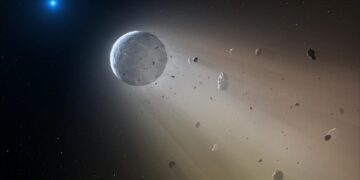For years, astronomers assumed that white dwarfs—stellar remnants left behind after a star like our Sun burns out—were cold, dead husks incapable of supporting life. However, a recent breakthrough has flipped this assumption on its head. New research suggests that some white dwarfs can pause their cooling for up to 10 billion years, keeping their habitable zones stable for the same duration as our Sun’s lifetime.
What Are White Dwarfs?
White dwarfs are the final evolutionary stage of stars like our Sun. When a star exhausts its nuclear fuel, it expands into a red giant before shedding its outer layers, leaving behind a hot, dense core—a white dwarf. These objects no longer produce energy through fusion, so they gradually cool over time, making it seem unlikely that they could host habitable planets.
Despite this, astronomers have discovered exoplanets orbiting white dwarfs, leading to speculation about their potential for life. These planets may have originally orbited further out and then migrated inward after the star became a white dwarf, potentially placing them within the habitable zone—the region where conditions could support liquid water.
The Habitability Challenge: Why White Dwarfs Seemed Unlikely Candidates
Until now, one of the biggest hurdles for habitability around white dwarfs was the fact that these stars cool down over time. As a white dwarf loses heat, its habitable zone shifts inward, meaning a planet that starts off in the right spot will eventually become too cold to sustain life.
However, the new research shows that for a subset of white dwarfs, this cooling process slows dramatically, extending the habitable zone’s stability. This gives planets in the right conditions a second chance at habitability—a concept that was previously dismissed.
How Some White Dwarfs Pause Their Cooling
The key to this discovery lies in a process called neon-22 distillation. While white dwarfs do not undergo fusion, their interiors still experience nuclear interactions and radioactive decay. Here’s how it works:
- As the white dwarf cools, heavy elements like neon-22 settle into the core.
- This settling process releases gravitational energy, which temporarily heats the star.
- The additional heat can pause the cooling process for up to 10 billion years.
This means that while most white dwarfs cool off relatively quickly, about 6% of them retain enough warmth to sustain a stable habitable zone for an extended period.
The Potential for Life on White Dwarf Planets
This new discovery means that some planets orbiting white dwarfs could remain habitable for the same amount of time as planets around main sequence stars like our Sun. If a planet in a white dwarf’s habitable zone retains water and an atmosphere, there’s a real possibility that life could develop.
For this to happen, a few conditions must be met:
- Planetary Migration: The planet must have moved into the habitable zone after the star became a white dwarf. This could happen due to gravitational interactions with other bodies.
- Retention of an Atmosphere: The planet would need to hold onto its atmosphere despite the intense radiation it endured during the red giant phase.
- Long-Term Stability: The planet must be able to stay in its new orbit long enough for life to take root.
While these conditions make habitability around white dwarfs unlikely, the fact that it is possible at all is groundbreaking.
Why This Discovery Matters
This revelation has huge implications for our search for extraterrestrial life. It means that white dwarfs with paused cooling should be prime targets for future exoplanet searches. Here’s why this discovery is so important:
- It Expands the Search for Life: Previously, we focused mainly on main sequence stars like our Sun. Now, we know that some white dwarfs may also host habitable planets.
- It Challenges Old Assumptions: Astronomers once thought white dwarf planets were doomed to become frozen wastelands. This research proves that some may remain warm for billions of years.
- It Highlights the Need for Further Study: Identifying which white dwarfs experience paused cooling will help us narrow down the best candidates for hosting habitable planets.
What Comes Next? Future Research and Observations
Now that we know some white dwarfs can pause their cooling, the next step is to find planets in these systems. Upcoming and existing telescopes will play a key role in this search:
- James Webb Space Telescope (JWST): With its ability to detect atmospheres around exoplanets, JWST could confirm whether planets around white dwarfs have retained their air and water.
- Vera C. Rubin Observatory: Scheduled to begin operations soon, this powerful telescope will help identify more planets orbiting white dwarfs.
- Future Space Missions: Proposed projects, such as the Habitable Worlds Observatory, could further refine our search for life in unexpected places.
Conclusion: A New Chapter in the Search for Life
This discovery about white dwarfs pausing their cooling is a game-changer in astrophysics and astrobiology. For the first time, we have evidence that some white dwarfs may remain warm enough to sustain habitable planets for billions of years—a finding that expands the potential for life beyond our original expectations.
Reference:
Vanderburg, Andrew, et al. “Long-lived Habitable Zones around White Dwarfs undergoing Neon-22 Distillation.”



















